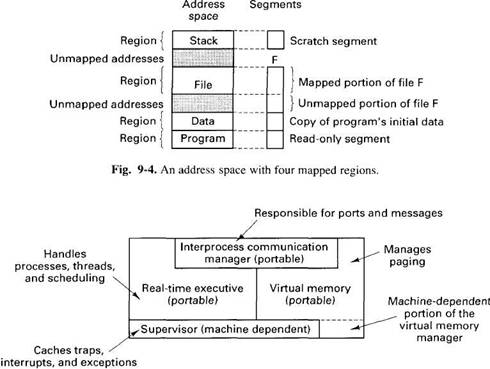Книга: Distributed operating systems
9.1.5. Kernel Structure
9.1.5. Kernel Structure
Having described the main abstractions provided by the Chorus kernel, let us now briefly examine how the kernel is structured internally. The kernel consists of four pieces, as illustrated in Fig. 9-5. At the bottom is the supervisor, which manages the raw hardware and catches traps, exceptions, interrupts, and other hardware details, and handles context switching. It is written partly in assembler and has to be redone when Chorus is ported to new hardware.

Fig. 9-5. Structure of the Chorus kernel.
Next comes the virtual memory manager, which handles the low-level part of the paging system. The largest piece of it deals with managing page caches and other logical concepts, and is machine independent. A small part, however, has to know how to load and store the MMU registers. This part is machine dependent and has to be modified when Chorus is ported to a new computer.
The two parts of the virtual memory manager together do not do all the work of managing the paging system. A third part, the mapper, is outside the kernel and does the high-level part. The communication protocol between the virtual memory manager and the mapper is well defined, so users can provide their own specialized mappers.
The third part of the kernel is the real-time executive. It is responsible for managing processes, threads, and scheduling. It also takes care of arranging for synchronization between threads for mutual exclusion and other purposes.
Finally, we have the interprocess communication manager, which handles uis, ports, and the sending of messages in a transparent way. It makes use of the services of the real-time executive and virtual memory manager to do its work. It is completely portable and does not have to be changed at all when Chorus is moved to a new platform. The four parts of the kernel are constructed in a modular way, so changes to one usually do not affect any of the others.
- 4.3.4. Kernel Configuration
- 8.1.4. Module Build Infrastructure
- 16.2.2. Customizing Kernel Initialization
- 16.3.2. Board Information Structure
- Kernel setup
- rc.firewall.txt script structure
- The structure
- Kernel Address Space
- Loading the Linux Kernel
- Structure of the shutdown File
- How Nameservers Store DNS Structure Information
- Perl Variables and Data Structures




